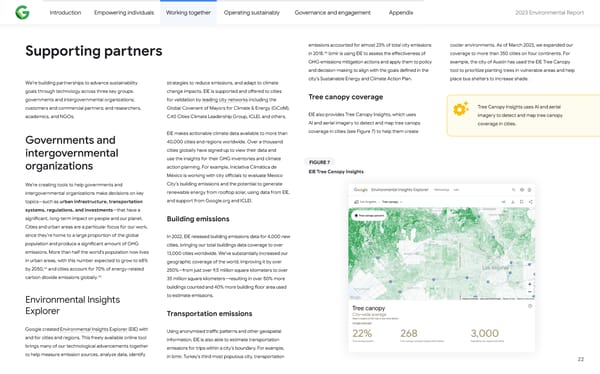Introduction Empowering individuals Working together Operating sustainably Governance and engagement Appendix 2023 Environmental Repo爀琀 emissions accounted for almost 23% of total city emissions cooler environments. As of March 2023, we expanded our 54 in 2018. Izmir is using EIE to assess the e昀昀ectiveness of coverage to more than 350 cities on four continents. For Suppo爀琀ing pa爀琀ners GHG emissions mitigation actions and apply them to policy example, the city of Austin has used the EIE Tree Canopy and decision-making to align with the goals de昀椀ned in the tool to prioritize planting trees in vulnerable areas and help city’s Sustainable Energy and Climate Action Plan. place bus shelters to increase shade. We’re building pa爀琀nerships to advance sustainability strategies to reduce emissions, and adapt to climate goals through technology across three key groups: change impacts. EIE is suppo爀琀ed and o昀昀ered to cities Tree canopy coverage governments and intergovernmental organizations; for validation by leading city networks including the customers and commercial pa爀琀ners; and researchers, Global Covenant of Mayors for Climate & Energy (GCoM), Tree Canopy Insights uses AI and aerial EIE also provides Tree Canopy Insights, which uses imagery to detect and map tree canopy academics, and NGOs. C40 Cities Climate Leadership Group, ICLEI, and others. AI and aerial imagery to detect and map tree canopy coverage in cities. coverage in cities (see Figure 7) to help them create EIE makes actionable climate data available to more than Governments and 40,000 cities and regions worldwide. Over a thousand intergovernmental cities globally have signed up to view their data and use the insights for their GHG inventories and climate FIGURE 7 organizations action planning. For example, Iniciativa Climática de EIE Tree Canopy Insights México is working with city o昀케cials to evaluate Mexico City’s building emissions and the potential to generate We’re creating tools to help governments and renewable energy from roo昀琀op solar, using data from EIE, intergovernmental organizations make decisions on key and suppo爀琀 from Google.org and ICLEI. topics—such as urban infrastructure, transpo爀琀ation systems, regulations, and investments—that have a signi昀椀cant, long-term impact on people and our planet. Building emissions Cities and urban areas are a pa爀琀icular focus for our work, since they’re home to a large propo爀琀ion of the global In 2022, EIE released building emissions data for 4,000 new population and produce a signi昀椀cant amount of GHG cities, bringing our total buildings data coverage to over emissions. More than half the world’s population now lives 13,000 cities worldwide. We’ve substantially increased our in urban areas, with this number expected to grow to 68% geographic coverage of the world, improving it by over 52 by 2050, and cities account for 70% of energy-related 250%—from just over 9.5 million square kilometers to over 53 carbon dioxide emissions globally. 35 million square kilometers—resulting in over 50% more buildings counted and 40% more building 昀氀oor area used to estimate emissions. Environmental Insights Explorer Transpo爀琀ation emissions Google created Environmental Insights Explorer (EIE) with Using anonymized tra昀케c pa琀琀erns and other geospatial and for cities and regions. This freely available online tool information, EIE is also able to estimate transpo爀琀ation brings many of our technological advancements together emissions for trips within a city’s boundary. For example, to help measure emission sources, analyze data, identify in Izmir, Turkey’s third most populous city, transpo爀琀ation 22
 2023 Environmental Report Page 21 Page 23
2023 Environmental Report Page 21 Page 23